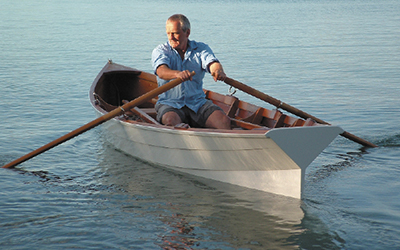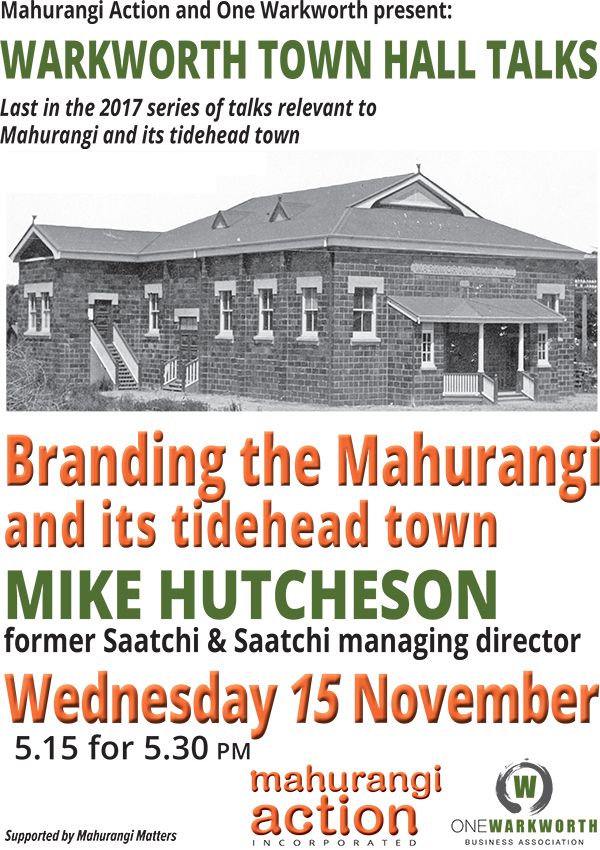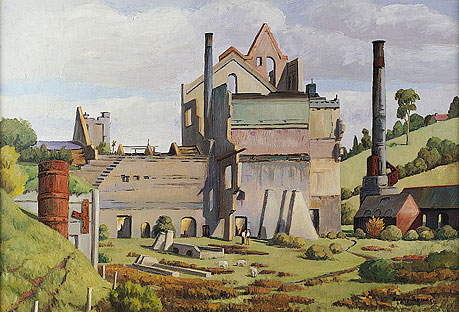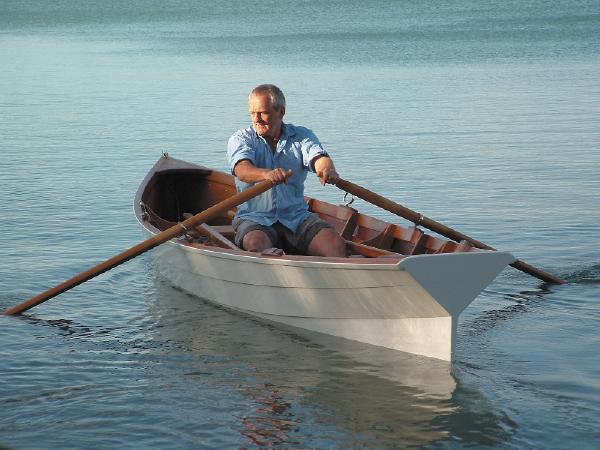Mahurangi punt – one of two icons

Introduced by Cimino 1 January 2008

Colonial Branding: So much of Aotearoa was branded by colonialists that names imported by nostalgic settlers, such as Warkworth by John Anderson Brown, barely give pause. If Mahurangi’s tidehead town was restored to a more authentic name—and while it was only adopted in the early colonial era, Mahurangi must be a top contender—it would certainly generate publicity heat. image Mahurangi Magazine
It was always intended that the content of the many Mahurangi Bulletins and the solitary printed edition of the Mahurangi Magazine would be published in the online Mahurangi Magazine.
Consistent with a New Year’s Resolution, the following article by Simon James, on the Mahurangi punt revival, is the beginning of that process.
The choice of Simon’s article was precipitated by the inquiries received from people keen to own a Mahurangi punt. And aside from their obvious heritage value, and the utility of a craft specifically designed for use over mudflats, the Mahurangi punt is perfect for the post–internal-combustion era. In calm conditions, a three-horsepower electric outboard would propel one of these craft 20 nautical miles on a single charge.
Mahurangi punt: One of two icons
Simon James
First published in Mahurangi Magazine January 2007
Punts are an absolutely integral, and unique, element of the settler history of Mahurangi. The centrality of these craft is graphically captured in the 1903 photograph of Willie Hamilton rowing a fully laden Mahurangi punt past the cement works established by his father-in-law, Nathaniel Wilson.
It has been a huge privilege for me to be a catalyst in the revival of the Mahurangi punt. I believe that, in time, not only will this graceful craft be seen as an integral and important part of our settler heritage, but also it will gain an international reputation as a truly superb vessel.

Unquestionably Iconic: There are several candidates for icons of Mahurangi’s tidehead town, including ducks crossing, blooming kōwhai, and the Jane Gifford. But even without its most phallic—almost 43-metre tall—chimney, excluded in this study, New Zealand’s first site of the continuous production of Portland cement, the Wilson Cement Works, is as uniquely Mahurangi as its eponymous punt, and considerably more prominent. oil on hardboard Peggy Spicer
All boats are an interplay of form and function. There are very few that achieve both as well and as elegantly as the Mahurangi punt. I take my hat off to the settlers who created the essential elements of the design, and that of its cousins, the Matakana and Kaipara punts. We don’t know to what extent they drew on the French Canadian bateau, the Newfoundland dory, the Venetian gondola or the wherry of the waterways of 17th, 18th and 19th century England—any or all of them could have been antecedents of a craft that is ultimately unique to Aotearoa.
Before I relate the personal journey that has led to the construction of the first kauri Mahurangi punts for 70 years, a brief description of the craft: It is a wooden skiff, 18ft 6in in length, but this can vary by a couple of feet from boat to boat. It is flat bottomed (usually with a fore and aft rocker of around three inches), with lapstrake sides, usually of three 10in planks. Key to the boat’s sublime rowing characteristics is that it is double-ended below the waterline—the bottom plank meeting below the transom. This means that there is no drag from a square stern to suck the energy out of a rower. It simply slides through the water with the grace of an ice skater doing one of those lovely long looping curves.
However, this is no mere pretty showboat. It was effectively the pickup truck of the Mahurangi; they carried loads of people, firewood, fish, livestock—whatever needed to be transported. The flat bottom meant that it could go just about anywhere—there are stories of them rowed across wet mud. The carrying capacity of the punts came from their open construction—amidships the sides flare from around 3ft 6in at the bottom to 4ft 6in at the gunwale. This flaring was transmitted through to the stern of the boat in one of its most distinctive and endearing features. The punt’s dainty, but functional Y-shaped stern is a product of the upper two planks carrying the midships flare aft, increasing its load capabilities significantly. It also leads to a very elegant, signature curve in the hull through the aft section of the boat (not easy to construct!).

Revivalist: Simon James at the oars of the Penelope, the first completed of two Mahurangi punts he constructed with boatbuilder Kerry Miller. image Miller family
I first came across the punts when reading Dr R H Locker’s masterly Jade River: A History of the Mahurangi, published by Mahurangi Actionestablished 1974 as Friends of the Mahurangi. Something about the chapter on the Mahurangi punts just grabbed me. I think it was the combination of being such an iconic part of our settler heritage, and their perfect fusion of form and function that inspired me.
A year or so of enthusing and talking with Jefferson Chapple and Kerry Miller followed, and we rowed Peter Thompson’s 21ft 6in replica punt at the 2005 Mahurangi Regatta. Kerry’s family’s three-generation association with punts, and his 25-year experience of boat building meant he was perfectly qualified for the task although, initially, he was rather circumspect. But when I bought some 10in x 4in kauri joists that had been part of a warehouse in Whangārei (through TradeMe) to use as raw material for planks etcetera, we were on our way.
It has been a grand journey for both of us—and not just the building of a couple of boats. Conversations have ranged from God, children, parents, boats, politics, architecture, the importance of quality in one’s life (and the absence of quality in so much of what is commercially available). We haven’t been scared to discuss our developing friendship either—two very different guys getting to know each other through the building of a couple of rather special boats. Kerry has acknowledged me as the ‘firelighter’ whose vision and enthusiasm has ensured the punts have seen the light of a new day. And I acknowledge Kerry as the complement to my vision—without his patience, commitment, experience and expertise, and willingness to listen and run with ideas, the boats would not have come into existence.
As our template, we worked off one of the very few punts still in existence—the ‘Kirby’ punt; originally built by Fred Anderson, owned by the Kirby family for 50 or so years, and since gifted to Mahurangi Action.
The punt has clearly worked hard over its 80–90-year life, and needs plenty of work to bring it back to what it once was, but it served its purpose as a basis from which to work. Incidentally, this is part of the punt tradition—apparently people would work off an earlier version, rather from a set of plans.
I served my apprenticeship on a wonderful first project. Kerry’s meticulous attention to detail, and my desire to build something that would truly represent the quality of this piece of our heritage mean that we have built boats to last a hundred years—just as Tom Morrison’s original has. Fortunately Tom intends to revive his grand old original. One small example of the quality of these boats—each of the five frames is made of nine separate pieces of kauri, each one hand-shaped, each with their separate curves running in three directions. The result: a boat with enormous structural integrity.
The construction process began with forming the bottom, gluing and screwing the chine on, then tomming the bottom to get the desired rockers—both fore and aft, and transverse. We then fabricated and put on the stem and stern posts, giving us a base from which to run battens fore and aft to give us our overall lines. This then enabled us to do the preliminary shaping of the frames, which after the 45 components had been assembled, led to reassessing the lines with battens, final shaping of the frames, then planking up. The bevels on the planks, particularly the upper two in the stern were fiendishly complex, but Kerry got it sorted. By now the boats actually looked like boats—sides, bottoms, hulls and bows and sterns. One of the features of the building of our two punts, Penelope and Ella Bella, was the meetings of the Design Committee—consisting of Kerry and myself. We had some excellent discussions, which called on all areas of our backgrounds—physics, maths, hydrodynamics, aesthetics and the odd cup of coffee or ten.
About this time, Brian Dawson, to his credit, saw the virtue in getting his family’s punt repaired. Kerry, now armed with his intimate knowledge of how they are put together, was able to resuscitate this key member of the three original Mahurangi punts still in existence.
Upon completion of that job, Kerry was able to get back to the finishing touches on Penelope—managing to get her into the water for a launching with family and close friends who had supported the punt project, the day before she was required for the celebrations marking the 150th anniversary of the first ordained Presbyterian minister in the district, Rev. McKinney. It was wonderful to see just how sweetly she moved through the water, and wonderful to see just how much she was appreciated by the hundreds at the Warkworth wharf for the commemoration.
At the time of writing, Ella Bella is awaiting the final push for completion. We intend there to again be a parade of punts at the Mahurangi Regatta; something that can only grow as people realise just what beautiful examples of nautical artisanship they are. Hugh Gladwell of Dyson, Smythe and Gladwell has undertaken to sponsor a trophy to cement the revival of the regatta punt event.
Rodney District Council’s work in saving that uniquely Mahurangi icon, the cement works, is widely acknowledged. And in Ōrewa, enjoying pride of place just inside the entrance of the council’s headquarters, is Peter Oxborough’s Te Haupa, a sculpture of the natural Mahurangi icon—the island thrown across the approaches to harbour.
It would seem entirely appropriate for the Kirby punt to be preserved and for its display to be included in the developments planned for the Wilson Cement Works.

It looks to me that the punt’s ancestor was a River Shannon gandelow. It has one of two common stern variants, and 18′ 6″ is a very popular size. The shape, construction, bottom beam, flare and beam at the rail are almost identical to the Irish boats.
Well spotted Glenn—how very interesting, given the early Irish families of the Mahurangi.
No small similarity is that both craft were built in locations where long, clean boards were available, and boards seldom came longer and cleaner than those of kauri. But what would the Limerickians would have given for pōhutukawa knees!
Although there does indeed appear to be a gandelow variant superficially similar, I have yet to find an image of a River Shannon craft with a posterior quite as petite as the Mahurangi punt’s martini-glass transom.